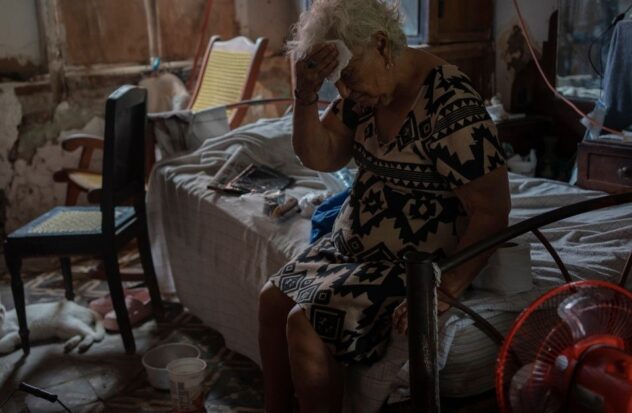Sweltering temperatures that caused heat stroke in parts of the United States were 35 times more likely and 1.4 degrees Celsius (2.5 degrees Fahrenheit) higher due to warming driven by the burning of coal, oil and natural gas, the study said. Thursday World Weather Attribution, an organization of scientists that conducts rapid, non-peer-reviewed studies on climate attribution.
“It’s an oven, you can’t be here,” said Margarita Salazar Pérez, 82, a resident of Veracruz, Mexico, in her home without air conditioning. Last week, the Sonoran Desert reached 125°F (51.9°C), the hottest day in Mexican history, according to study co-author Shel Winkley, a Climate Central meteorologist.
And it was even worse at night, which is what made this heat wave so deadly, said Imperial College of London climate scientist Friederike Otto, who coordinates the attribution team. Climate change made nighttime temperatures 1.6°C (2.9°F) higher and increased the likelihood of unusual afternoon heat by 200 times, she said.
There was simply no fresh air at night, as people are used to, Salazar Pérez said. Doctors say cooler nighttime temperatures are key to surviving a heat wave.
At least 125 people have died so far, according to the World Weather Attribution team.
Karina Izquierdo, urban advisor for the Red Cross and Red Crescent climate center in Mexico City and co-author of the report, said the level of intensity and risks associated with the phenomenon are clearly related to climate change.
The alarming part about this heat wave, which is still technically scorching North America, is that it is no longer off the charts, Otto said. Previous studies by the group have analyzed temperatures so extreme that they considered them impossible without climate change, but that is not the case with this heat wave.
“From a time perspective, in that sense it was not unusual, but in reality the effects were very serious,” Otto told The Associated Press in an interview.
“The changes we have seen in the last 20 years, which seem like just yesterday, are very strong,” he explained. His study concluded that this heat wave is four times more likely to occur now than in 2000, when temperatures were 0.5°C (almost one degree Fahrenheit) lower than now. “It seems like a far away and different world.”
Although other groups of international scientists — and the global carbon dioxide emissions reduction targets approved by countries in the 2015 Paris climate agreement — refer to warming since the pre-industrial era, in the 19th century, Otto said that comparing what What happens now with the year 2000 is more shocking.
“We are seeing a changing frame of reference, what was once extreme but unusual is becoming more common,” said Carly Kenkel, chair of Marine Studies at the University of Southern California, who was not involved in the attribution team’s study. . Analysis, she noted, is “the logical conclusion according to the data.”
The study focused on a broad section of the continent that included California, Arizona, New Mexico, Texas, Oklahoma, Mexico, Guatemala, El Salvador, Belize and Honduras, and the five consecutive warmest days and five consecutive warmest nights. For most of those places, those five days were June 3-7, and the nights June 5-9. But in some places, peak heat began on May 26, Otto said.
For example, San Angelo, Texas, hit a record high of 111°F (43.8°C) on June 4. Between June 2 and June 6, the nighttime temperature did not drop below 80°F (26.7°C) at the Corpus Christi airport, a record nightly temperature, and there were two days in which the thermometer never fell below 85ºF (29.4ºC), according to the National Weather Service.
Between June 1 and June 15, the United States tied or broke more than 1,200 daily high temperature records and reached nearly 1,800 overnight high temperature records, according to the National Center for Environmental Information.
The attribution team used current and past measurements to compare the current situation with previous heat waves. They then used a technique accepted in the scientific community, comparing simulations of a fictional world without climate change caused by humanity, with current reality, to determine when global warming influenced the 2024 heat wave.
The immediate meteorological cause was a high pressure system parked over central Mexico that blocked the advance of clouds and storms that would have lowered temperatures, and then moved toward the southwest of the United States. It’s now bringing heat to the eastern United States, Winkley explained. Tropical Storm Alberto formed Wednesday and is headed toward northern Mexico and southern Texas with some rain, which could cause flooding.
Mexico and other places have suffered months of drought, lack of water and brutal heat. The heat has caused monkeys to fall from trees in Mexico.
This heat wave aggravates existing inequalities between rich and poor on the American continent, Izquierdo said, and Kenkel agreed. The nighttime heat makes that disparity evident because the ability to cool off with air conditioning depends on people’s financial means, Kenkel said.
And that means that during this heat wave, Salazar Pérez has found herself very uncomfortable.
Source: With information from AP


